Artificial Intelligence: A Comprehensive Report on Current Trends
VerifiedAdded on 2019/09/20
|7
|1666
|306
Report
AI Summary
This report offers a comprehensive overview of Artificial Intelligence (AI), encompassing its definition as machine intelligence capable of solving problems and mimicking human thought processes. It explores the evolution of AI, from its conceptualization to its practical applications across various fields, including medicine, robotics, and gaming. The report highlights the advantages of AI, such as cost reduction, adaptability, and dependability, while also addressing its limitations, including its reliance on human oversight and the high initial costs. The report also provides the comparison between human intelligence and artificial intelligence and covers different methodologies and strategies used for AI development. It also touches on the future prospects of AI, emphasizing its potential to revolutionize various scientific and technological domains and the need for continued research and development to bridge the gap between human and artificial intelligence. The report concludes by emphasizing the ongoing evolution of AI and its potential to address complex challenges.
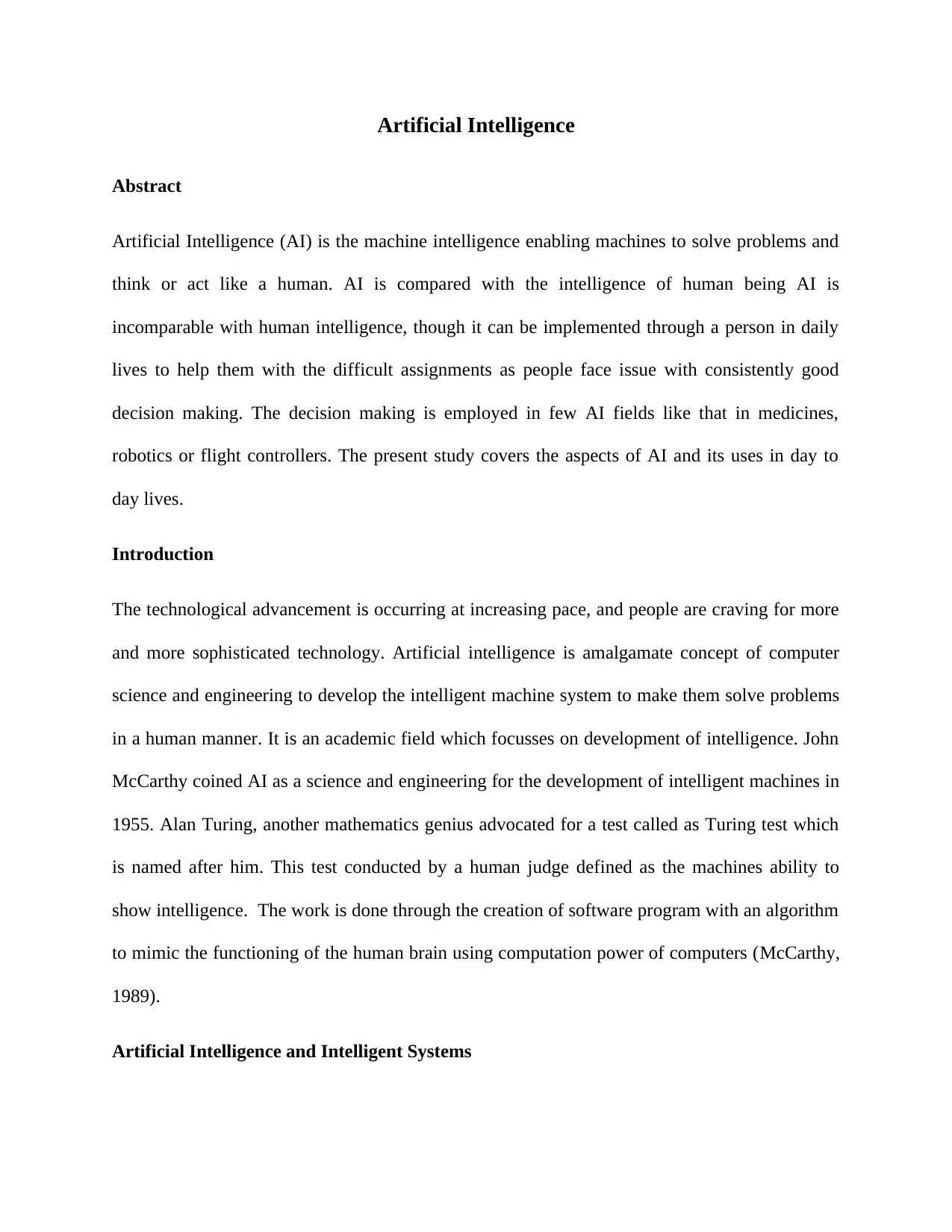
Artificial Intelligence
Abstract
Artificial Intelligence (AI) is the machine intelligence enabling machines to solve problems and
think or act like a human. AI is compared with the intelligence of human being AI is
incomparable with human intelligence, though it can be implemented through a person in daily
lives to help them with the difficult assignments as people face issue with consistently good
decision making. The decision making is employed in few AI fields like that in medicines,
robotics or flight controllers. The present study covers the aspects of AI and its uses in day to
day lives.
Introduction
The technological advancement is occurring at increasing pace, and people are craving for more
and more sophisticated technology. Artificial intelligence is amalgamate concept of computer
science and engineering to develop the intelligent machine system to make them solve problems
in a human manner. It is an academic field which focusses on development of intelligence. John
McCarthy coined AI as a science and engineering for the development of intelligent machines in
1955. Alan Turing, another mathematics genius advocated for a test called as Turing test which
is named after him. This test conducted by a human judge defined as the machines ability to
show intelligence. The work is done through the creation of software program with an algorithm
to mimic the functioning of the human brain using computation power of computers (McCarthy,
1989).
Artificial Intelligence and Intelligent Systems
Abstract
Artificial Intelligence (AI) is the machine intelligence enabling machines to solve problems and
think or act like a human. AI is compared with the intelligence of human being AI is
incomparable with human intelligence, though it can be implemented through a person in daily
lives to help them with the difficult assignments as people face issue with consistently good
decision making. The decision making is employed in few AI fields like that in medicines,
robotics or flight controllers. The present study covers the aspects of AI and its uses in day to
day lives.
Introduction
The technological advancement is occurring at increasing pace, and people are craving for more
and more sophisticated technology. Artificial intelligence is amalgamate concept of computer
science and engineering to develop the intelligent machine system to make them solve problems
in a human manner. It is an academic field which focusses on development of intelligence. John
McCarthy coined AI as a science and engineering for the development of intelligent machines in
1955. Alan Turing, another mathematics genius advocated for a test called as Turing test which
is named after him. This test conducted by a human judge defined as the machines ability to
show intelligence. The work is done through the creation of software program with an algorithm
to mimic the functioning of the human brain using computation power of computers (McCarthy,
1989).
Artificial Intelligence and Intelligent Systems
Paraphrase This Document
Need a fresh take? Get an instant paraphrase of this document with our AI Paraphraser

AI is the application developed for the machine to imitate the cognitive skills of human brain like
learning, problem-solving, etc. AI is an outcome of computer revolution through which the
systems were constructed to behave intellectually, think rationally and have the ability respond to
the environmental factors in a real-time manner. AI systems outperform scientists and
researchers in the way or thinking and performance (Poo et al., 2016). The following graph
shows the number software projects by Google that uses AI (Figure 1).
Figure 1:Use of AI by Google (Source: Google)
AI is not a new concept, and even in ancient times, humans have always been fascinated for the
invention of intelligent machinery. Therefore, researchers have been putting their effort to
develop the systems and programs to mimic human brain and evolve machines with the ability to
perform similarly to the human. It was only in the last century some fruitful inventions took
place which made AI a plausible reality. The very first benchmark was started by Alan Turing
who is widely acknowledged for the development of a code breaking machine during the world
war. After that, the concept of AI has come a long way from the old days. Scientists have been
encouraged to develop AI systems because of the development of the computers. The innovation
was accessible for a long time and stimulate the intelligent behavior. The knowledge and
learning, problem-solving, etc. AI is an outcome of computer revolution through which the
systems were constructed to behave intellectually, think rationally and have the ability respond to
the environmental factors in a real-time manner. AI systems outperform scientists and
researchers in the way or thinking and performance (Poo et al., 2016). The following graph
shows the number software projects by Google that uses AI (Figure 1).
Figure 1:Use of AI by Google (Source: Google)
AI is not a new concept, and even in ancient times, humans have always been fascinated for the
invention of intelligent machinery. Therefore, researchers have been putting their effort to
develop the systems and programs to mimic human brain and evolve machines with the ability to
perform similarly to the human. It was only in the last century some fruitful inventions took
place which made AI a plausible reality. The very first benchmark was started by Alan Turing
who is widely acknowledged for the development of a code breaking machine during the world
war. After that, the concept of AI has come a long way from the old days. Scientists have been
encouraged to develop AI systems because of the development of the computers. The innovation
was accessible for a long time and stimulate the intelligent behavior. The knowledge and
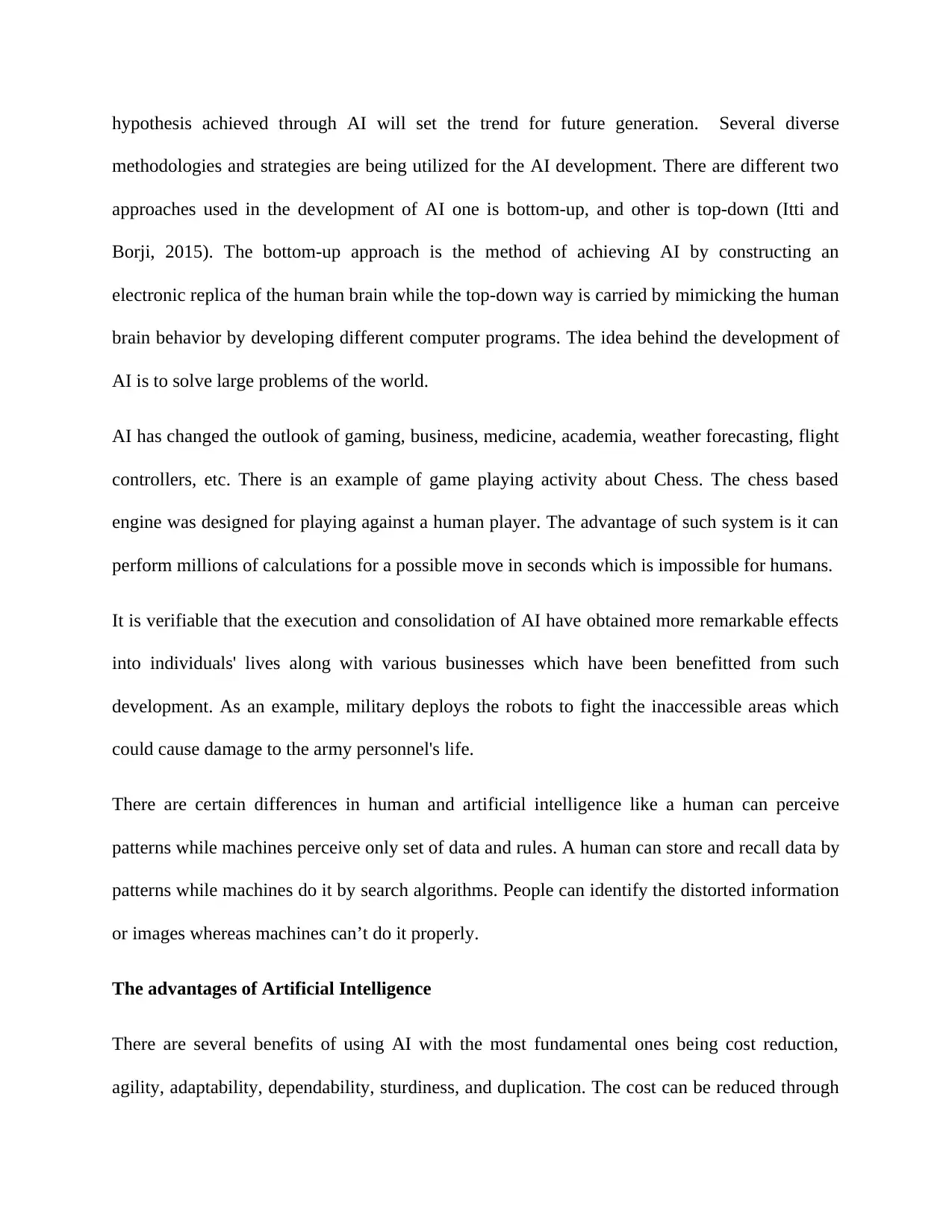
hypothesis achieved through AI will set the trend for future generation. Several diverse
methodologies and strategies are being utilized for the AI development. There are different two
approaches used in the development of AI one is bottom-up, and other is top-down (Itti and
Borji, 2015). The bottom-up approach is the method of achieving AI by constructing an
electronic replica of the human brain while the top-down way is carried by mimicking the human
brain behavior by developing different computer programs. The idea behind the development of
AI is to solve large problems of the world.
AI has changed the outlook of gaming, business, medicine, academia, weather forecasting, flight
controllers, etc. There is an example of game playing activity about Chess. The chess based
engine was designed for playing against a human player. The advantage of such system is it can
perform millions of calculations for a possible move in seconds which is impossible for humans.
It is verifiable that the execution and consolidation of AI have obtained more remarkable effects
into individuals' lives along with various businesses which have been benefitted from such
development. As an example, military deploys the robots to fight the inaccessible areas which
could cause damage to the army personnel's life.
There are certain differences in human and artificial intelligence like a human can perceive
patterns while machines perceive only set of data and rules. A human can store and recall data by
patterns while machines do it by search algorithms. People can identify the distorted information
or images whereas machines can’t do it properly.
The advantages of Artificial Intelligence
There are several benefits of using AI with the most fundamental ones being cost reduction,
agility, adaptability, dependability, sturdiness, and duplication. The cost can be reduced through
methodologies and strategies are being utilized for the AI development. There are different two
approaches used in the development of AI one is bottom-up, and other is top-down (Itti and
Borji, 2015). The bottom-up approach is the method of achieving AI by constructing an
electronic replica of the human brain while the top-down way is carried by mimicking the human
brain behavior by developing different computer programs. The idea behind the development of
AI is to solve large problems of the world.
AI has changed the outlook of gaming, business, medicine, academia, weather forecasting, flight
controllers, etc. There is an example of game playing activity about Chess. The chess based
engine was designed for playing against a human player. The advantage of such system is it can
perform millions of calculations for a possible move in seconds which is impossible for humans.
It is verifiable that the execution and consolidation of AI have obtained more remarkable effects
into individuals' lives along with various businesses which have been benefitted from such
development. As an example, military deploys the robots to fight the inaccessible areas which
could cause damage to the army personnel's life.
There are certain differences in human and artificial intelligence like a human can perceive
patterns while machines perceive only set of data and rules. A human can store and recall data by
patterns while machines do it by search algorithms. People can identify the distorted information
or images whereas machines can’t do it properly.
The advantages of Artificial Intelligence
There are several benefits of using AI with the most fundamental ones being cost reduction,
agility, adaptability, dependability, sturdiness, and duplication. The cost can be reduced through
⊘ This is a preview!⊘
Do you want full access?
Subscribe today to unlock all pages.

Trusted by 1+ million students worldwide
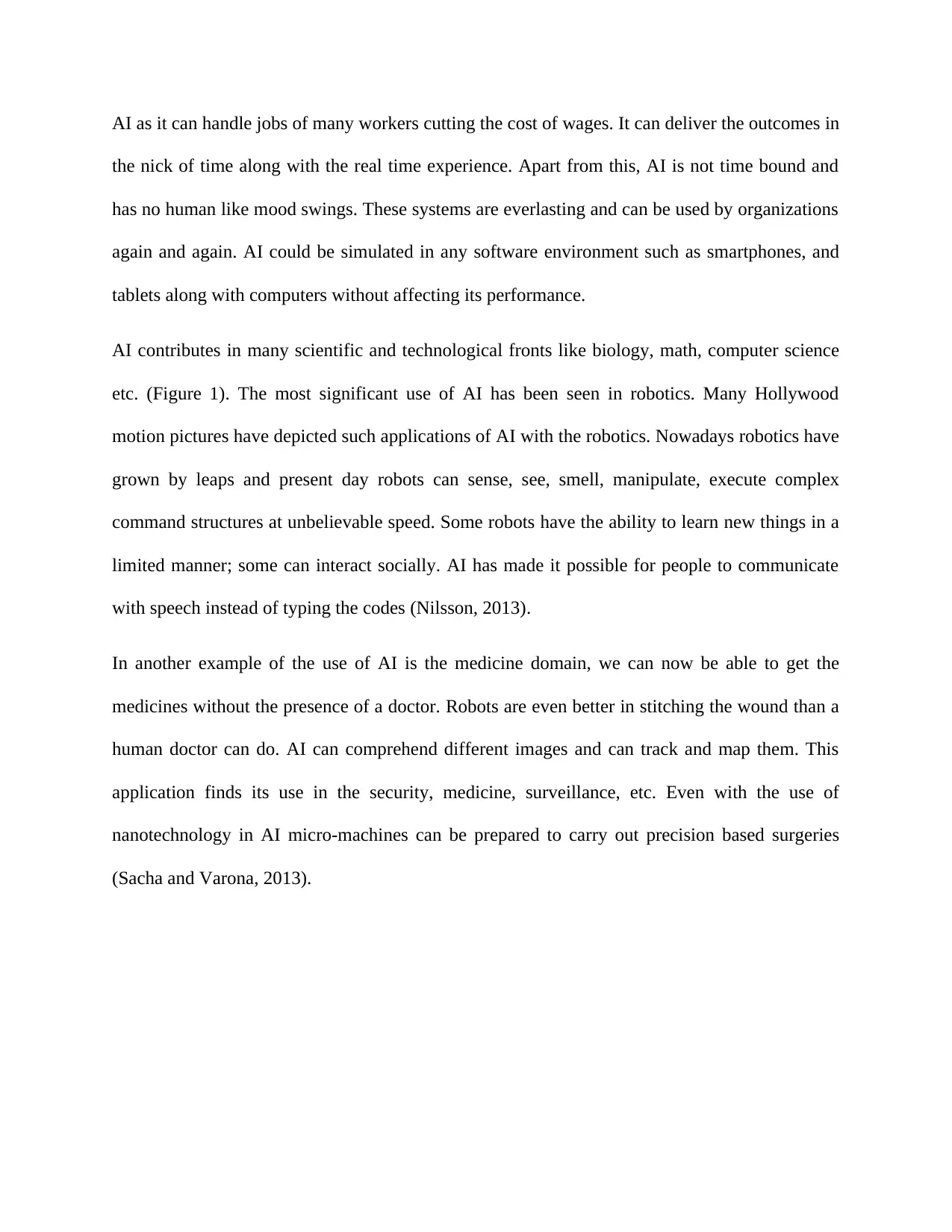
AI as it can handle jobs of many workers cutting the cost of wages. It can deliver the outcomes in
the nick of time along with the real time experience. Apart from this, AI is not time bound and
has no human like mood swings. These systems are everlasting and can be used by organizations
again and again. AI could be simulated in any software environment such as smartphones, and
tablets along with computers without affecting its performance.
AI contributes in many scientific and technological fronts like biology, math, computer science
etc. (Figure 1). The most significant use of AI has been seen in robotics. Many Hollywood
motion pictures have depicted such applications of AI with the robotics. Nowadays robotics have
grown by leaps and present day robots can sense, see, smell, manipulate, execute complex
command structures at unbelievable speed. Some robots have the ability to learn new things in a
limited manner; some can interact socially. AI has made it possible for people to communicate
with speech instead of typing the codes (Nilsson, 2013).
In another example of the use of AI is the medicine domain, we can now be able to get the
medicines without the presence of a doctor. Robots are even better in stitching the wound than a
human doctor can do. AI can comprehend different images and can track and map them. This
application finds its use in the security, medicine, surveillance, etc. Even with the use of
nanotechnology in AI micro-machines can be prepared to carry out precision based surgeries
(Sacha and Varona, 2013).
the nick of time along with the real time experience. Apart from this, AI is not time bound and
has no human like mood swings. These systems are everlasting and can be used by organizations
again and again. AI could be simulated in any software environment such as smartphones, and
tablets along with computers without affecting its performance.
AI contributes in many scientific and technological fronts like biology, math, computer science
etc. (Figure 1). The most significant use of AI has been seen in robotics. Many Hollywood
motion pictures have depicted such applications of AI with the robotics. Nowadays robotics have
grown by leaps and present day robots can sense, see, smell, manipulate, execute complex
command structures at unbelievable speed. Some robots have the ability to learn new things in a
limited manner; some can interact socially. AI has made it possible for people to communicate
with speech instead of typing the codes (Nilsson, 2013).
In another example of the use of AI is the medicine domain, we can now be able to get the
medicines without the presence of a doctor. Robots are even better in stitching the wound than a
human doctor can do. AI can comprehend different images and can track and map them. This
application finds its use in the security, medicine, surveillance, etc. Even with the use of
nanotechnology in AI micro-machines can be prepared to carry out precision based surgeries
(Sacha and Varona, 2013).
Paraphrase This Document
Need a fresh take? Get an instant paraphrase of this document with our AI Paraphraser

Figure 1: Artificial intelligence and different field which has major contribution of AI
The various tools which are employed in AI are mathematical optimization tools, probability
methods.
Systems Without AI AI systems
Can answer only specific question Can solve generic question requiring
some sort of calculations
Entire structure changes with the
change in program
Adaptive and can insert modifications
without disturbing the program structure
Modifications are troublesome and can
affect program
Quick and Easy program modification.
The various tools which are employed in AI are mathematical optimization tools, probability
methods.
Systems Without AI AI systems
Can answer only specific question Can solve generic question requiring
some sort of calculations
Entire structure changes with the
change in program
Adaptive and can insert modifications
without disturbing the program structure
Modifications are troublesome and can
affect program
Quick and Easy program modification.
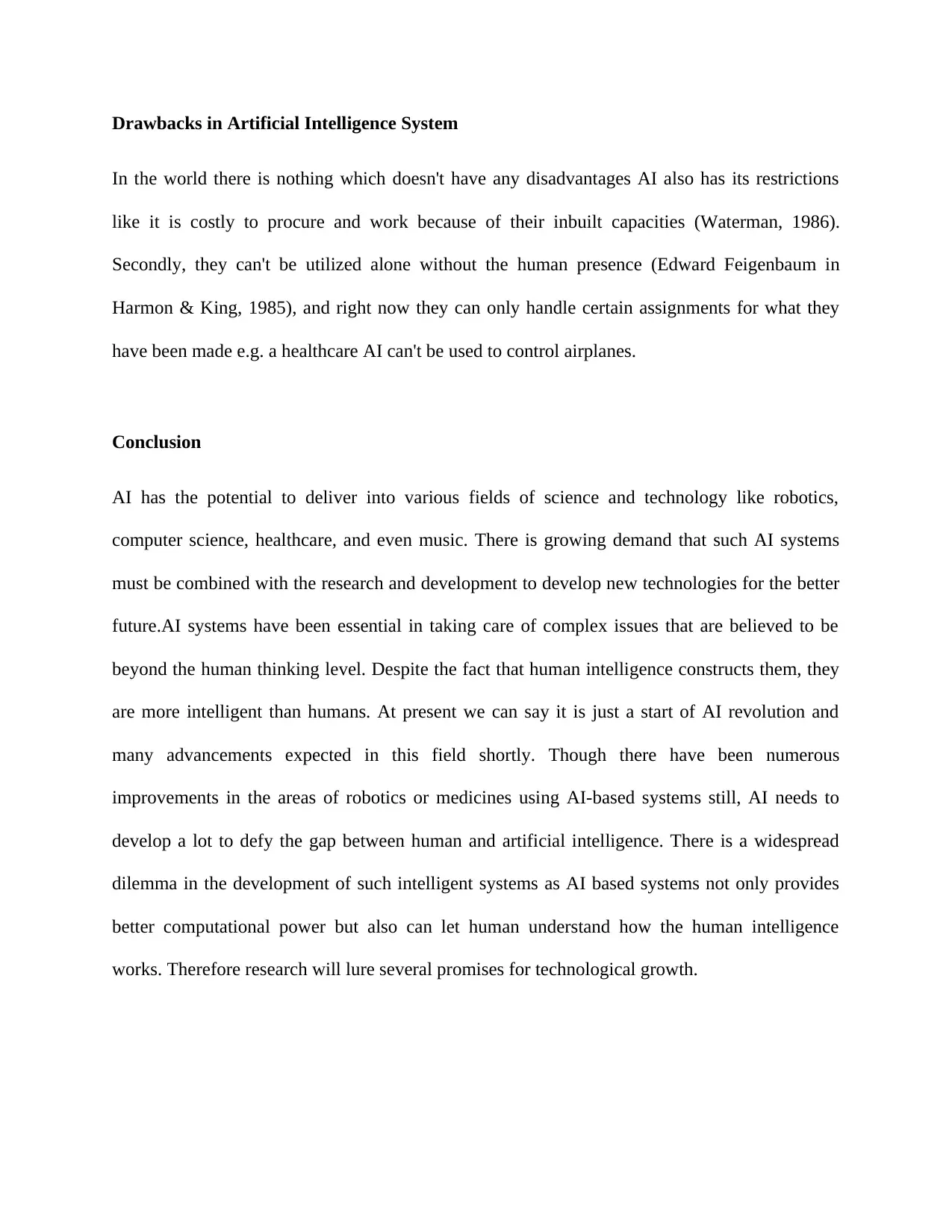
Drawbacks in Artificial Intelligence System
In the world there is nothing which doesn't have any disadvantages AI also has its restrictions
like it is costly to procure and work because of their inbuilt capacities (Waterman, 1986).
Secondly, they can't be utilized alone without the human presence (Edward Feigenbaum in
Harmon & King, 1985), and right now they can only handle certain assignments for what they
have been made e.g. a healthcare AI can't be used to control airplanes.
Conclusion
AI has the potential to deliver into various fields of science and technology like robotics,
computer science, healthcare, and even music. There is growing demand that such AI systems
must be combined with the research and development to develop new technologies for the better
future.AI systems have been essential in taking care of complex issues that are believed to be
beyond the human thinking level. Despite the fact that human intelligence constructs them, they
are more intelligent than humans. At present we can say it is just a start of AI revolution and
many advancements expected in this field shortly. Though there have been numerous
improvements in the areas of robotics or medicines using AI-based systems still, AI needs to
develop a lot to defy the gap between human and artificial intelligence. There is a widespread
dilemma in the development of such intelligent systems as AI based systems not only provides
better computational power but also can let human understand how the human intelligence
works. Therefore research will lure several promises for technological growth.
In the world there is nothing which doesn't have any disadvantages AI also has its restrictions
like it is costly to procure and work because of their inbuilt capacities (Waterman, 1986).
Secondly, they can't be utilized alone without the human presence (Edward Feigenbaum in
Harmon & King, 1985), and right now they can only handle certain assignments for what they
have been made e.g. a healthcare AI can't be used to control airplanes.
Conclusion
AI has the potential to deliver into various fields of science and technology like robotics,
computer science, healthcare, and even music. There is growing demand that such AI systems
must be combined with the research and development to develop new technologies for the better
future.AI systems have been essential in taking care of complex issues that are believed to be
beyond the human thinking level. Despite the fact that human intelligence constructs them, they
are more intelligent than humans. At present we can say it is just a start of AI revolution and
many advancements expected in this field shortly. Though there have been numerous
improvements in the areas of robotics or medicines using AI-based systems still, AI needs to
develop a lot to defy the gap between human and artificial intelligence. There is a widespread
dilemma in the development of such intelligent systems as AI based systems not only provides
better computational power but also can let human understand how the human intelligence
works. Therefore research will lure several promises for technological growth.
⊘ This is a preview!⊘
Do you want full access?
Subscribe today to unlock all pages.

Trusted by 1+ million students worldwide
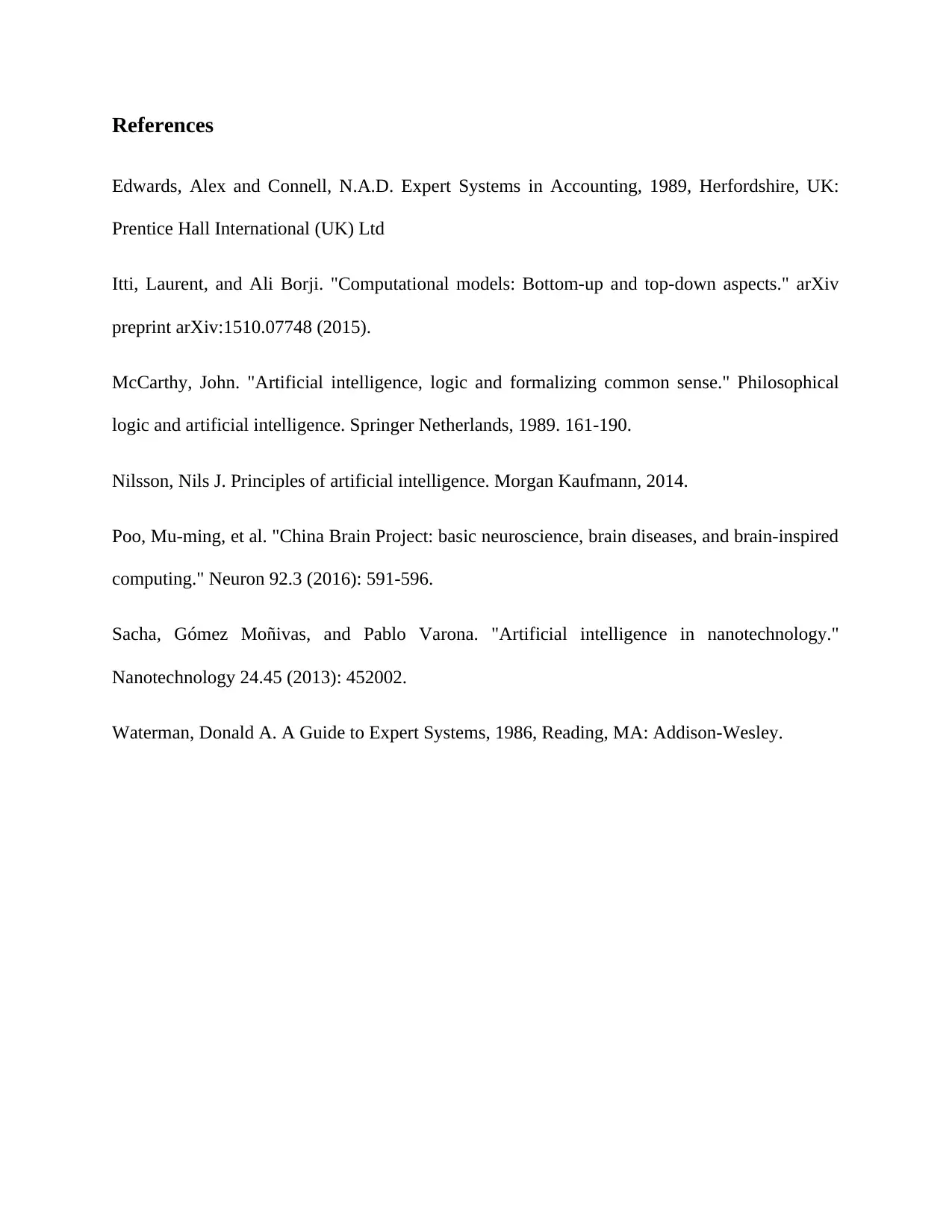
References
Edwards, Alex and Connell, N.A.D. Expert Systems in Accounting, 1989, Herfordshire, UK:
Prentice Hall International (UK) Ltd
Itti, Laurent, and Ali Borji. "Computational models: Bottom-up and top-down aspects." arXiv
preprint arXiv:1510.07748 (2015).
McCarthy, John. "Artificial intelligence, logic and formalizing common sense." Philosophical
logic and artificial intelligence. Springer Netherlands, 1989. 161-190.
Nilsson, Nils J. Principles of artificial intelligence. Morgan Kaufmann, 2014.
Poo, Mu-ming, et al. "China Brain Project: basic neuroscience, brain diseases, and brain-inspired
computing." Neuron 92.3 (2016): 591-596.
Sacha, Gómez Moñivas, and Pablo Varona. "Artificial intelligence in nanotechnology."
Nanotechnology 24.45 (2013): 452002.
Waterman, Donald A. A Guide to Expert Systems, 1986, Reading, MA: Addison-Wesley.
Edwards, Alex and Connell, N.A.D. Expert Systems in Accounting, 1989, Herfordshire, UK:
Prentice Hall International (UK) Ltd
Itti, Laurent, and Ali Borji. "Computational models: Bottom-up and top-down aspects." arXiv
preprint arXiv:1510.07748 (2015).
McCarthy, John. "Artificial intelligence, logic and formalizing common sense." Philosophical
logic and artificial intelligence. Springer Netherlands, 1989. 161-190.
Nilsson, Nils J. Principles of artificial intelligence. Morgan Kaufmann, 2014.
Poo, Mu-ming, et al. "China Brain Project: basic neuroscience, brain diseases, and brain-inspired
computing." Neuron 92.3 (2016): 591-596.
Sacha, Gómez Moñivas, and Pablo Varona. "Artificial intelligence in nanotechnology."
Nanotechnology 24.45 (2013): 452002.
Waterman, Donald A. A Guide to Expert Systems, 1986, Reading, MA: Addison-Wesley.
1 out of 7
Related Documents
Your All-in-One AI-Powered Toolkit for Academic Success.
+13062052269
info@desklib.com
Available 24*7 on WhatsApp / Email
![[object Object]](/_next/static/media/star-bottom.7253800d.svg)
Unlock your academic potential
Copyright © 2020–2025 A2Z Services. All Rights Reserved. Developed and managed by ZUCOL.





